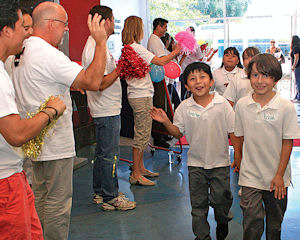Running a charity has always been difficult. But in a sluggish economy, getting local donors to part with their money is even harder, and the nonprofit sector in the greater San Fernando Valley has been through some tough times in the last few years. For many groups on the Business Journal’s list of 40 Largest Nonprofit Organizations, cutting services wasn’t an option. They say they’ve had no choice but to be savvy marketers. From rebranding to new business models to earmarked campaign drives, organizations have become more creative and more targeted in seeking donations. Consider Meet Each Need with Dignity. For years, the Pacoima nonprofit relied largely on small cash donations to fund its mission of assisting families living in poverty. Now, it’s broadened its strategy to focus on both large donors – who can bequeath money, property or assets to the organization – to those who have can provide in-kind donations of services or simply drop off food. “We’re working on a new strategic plan and one of the things we’re doing is looking at large donors,” said Chief Executive Marianne Haver Hill. “We’re developing a more targeted strategy. (And) we’ve managed to get enough volunteers to give of their time that we’ve saved the equivalent of 90 full-time staff salaries.” It’s those kinds of savings that helped the group sponsor a back-to-school event on Aug. 29 at a Pacoima elementary school. The third graders were provided with backpacks, basic school supplies and shoes they couldn’t afford. Still, Hill said she spends as much time trying to find ways to fund the organization as she does running it –like many others in her position. Nationally, a drop in both individual and corporate giving reduced donations to charities by $13 billion, or 4.3 percent, to $290 billion in 2010, according to the Giving Institute, a Chicago-based trade association for nonprofits. The situation improved last year as donations rose $8 billion, but at the same time, the groups are fighting a trend of shrinking government support, from the municipal to the national level. But leaders at many area nonprofits are resourceful and have been able to keep afloat with a variety of strategies. The Child Care Resource Center in Chatsworth primarily provides child care for welfare-to-work recipients. It renegotiated every one of its vendor contracts to get better prices and also focused on increasing goods donations, especially through its annual book and toy drive. “Most of our funding comes from the government through grants,” said Chief Executive Michael Olenick. “And we’ve seen a steady decline in recent years. We’ve had to cut some services, but now we’re also working with other funders.” That loss of state funding meant the organization had to eliminate an after-school program two years ago. Now the program has returned, though smaller. “It was a $39 million program, and now it’s an $11 million program. That means we’re able to take fewer children,” Olenick said. The Burbank Community YMCA saw increased revenue and assets in the last year, thanks mainly to a fundraising drive for improvements to the organization’s facilities. “We’re in a capital campaign,” said Chief Executive JC Holt. “We’re trying to fund remodels and renovations to our facilities that need to be done.” He said the drive has raised much of the funds from donors who have a connection to the organization. “Some has come from small foundations, but we have a lot of individual donors. These are all folks who have a Y connection,” he said. Then there’s the be.group, the third-largest organization on the Business Journal’s list. It was founded in 1955 as Southern California Presbyterian Homes. Last spring, the senior living nonprofit shed the moniker in favor of something more marketable and less restrictive in describing its mission. (See story page one.) The good news for nonprofits is that many in the field believe things can’t get much worse, and could get better as the economy mends. Still, the recent downturn has led many to rethink their reliance on traditional sources of funding. “I want to ensure we have high-quality services, and that means that I have to make sure to provide as many opportunities for donors to give as possible,” said Hill of Meet Each Need with Dignity. “Whether that means through clothing, a check or volunteering, we have to look at everything.” Download the 2012 VALLEY’S LARGEST FIXED BASED OPERATORS list (pdf)
